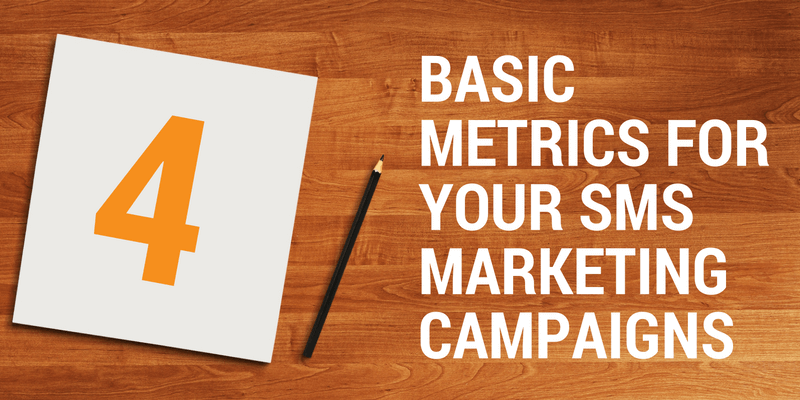4 Basic Metrics for Your SMS Marketing Campaigns

One key to successful marketing is to know when you’re doing it right. And when you’re doing it wrong. The great thing about SMS marketing is you can get that information pretty quickly. The messages get sent out fast, and generally the actions taken on those messages are quick as well. But to understand how your messages are performing, you need to do a little maths. Thankfully, it’s all rather simple once you see it.
List growth
One of the first questions marketers usually ask is “How many subscribers do I have?” While that’s a useful question, it isn’t the end of that train of thought. It’s most useful to know whether the number of subscribers is increasing or decreasing overall. You’ll need to know three things to calculate list growth: the number of subscribers you had before, the number you have currently, and the time between then and now.
For example say you had 100 subscribers at the end of last month. At the end of this month you have 250. Calculate your growth rate by using the following formula: Subtract last month’s number from this month’s number. Then divide that result by last month’s number. In the example above the maths look like this: (250-100)/100 = 1.5. Since there was one month between those two numbers your growth rate is 1.5 per month, or if you prefer percentages, just multiply by 100 to get 150% per month. The time period doesn’t have to be a month. You can check it on a daily, weekly, hourly rate depending on what your own goals are.
If the growth rate is positive then your list is growing. If your growth rate turns out to be negative, it isn’t an error (probably, double check your maths!). It means you’re losing more subscribers than you are gaining. Which leads to the next metric…
Opt out/churn rate
People will always opt out from your list. There’s a variety of reasons for this. Many might have nothing to do with your offers, but some of them will. If you diligently keep track of your opt outs and churn rates you’ll know when you’ve done something wrong. But first, let’s get to the difference between opt out and churn rates (some will say there is none and they aren’t wrong. I make a small distinction between the two). The difference is time and method. Both measure the number of people who leave your list. Opt out only counts those that officially opt out using the defined protocol in your message. But there are other ways people can leave your list. They may switch mobiles and have a new number which means their old number may become invalid. This doesn’t happen as much as it does with email addresses, but it could happen. The other difference is churn rates are usually calculated over some period of time, often weeks or months. Opt outs usually happen within the first 24 hours of a message, and that is being generous.
Here’s how to calculate them both. Divide the number of opt outs by the total number of subscribers (the number of subscribers before the opt outs!) You can usually do this shortly after a message is sent out to see how it affected your subscribers. A higher opt out rate means your message didn’t do as well as usual. You might want to change something. This gives you the opt out rate for a particular message.

To calculate churn rate, you can add the number of subscribers lost by non-opt out methods (probably a very low number, if any at all for SMS) to the opt out number before dividing by the total number of subscribers. As I mentioned, this is usually counted over weeks or months of a campaign. Or calculated on a per month basis to give a picture of how many subscribers you are losing over time. The time period doesn’t matter so much, as long as it is meaningful to you.
Redemption and click rates
How many subscribers took advantage of your offer? It’s easy to find out how effective your marketing message was by dividing the number of redemptions (or clicks if you sent a link) by the total number of subscribers. Usually that number is multiplied by 100 to get a final percentage. It looks like this: 120 subscribers redeemed the offer. You have 1000 subscribers in total. The redemption rate is 120/1000 = .12 or 12%
Cost per customer
All the above metrics are great, but ultimately you need to know if your marketing funds are being spent wisely. Here’s how you figure it out. Find the cost per SMS message you sent (as low as 2.1p with fastsms) and divide by the redemption rate you calculated above (important! Divide by the rate, not the percentage). Sticking with the example above, here’s how to find the cost per customer: 2.1p/.12 = 17.5p per redemption (or customer). If you made more than 17.5p per redemption, then you made a profit. Obviously the lower the cost per redemption the better, since your profits will be higher.
Examining these metrics for each message and over time can help you identify the best and worst of your marketing. You can use these simple metrics for A/B testing as well if you choose to do that with your large lists. And together they help answer the ultimate question: “Is SMS marketing working for me?”
Related Articles
5 SMS Marketing Ideas for Valentine’s Day [Infographic]
3 Reasons SMS Messaging is the Best Choice to Contact Everyone on Your List
One of the many benefits of SMS messaging is that it's personal. It can feel like a one on one communication or even conversation. But it's also one of the best ways to reach 10, 100, or even 100,000 people all at once. So even "one to many" communication feels like "one to one" to the receiver.
Copywriting Principles for SMS Marketing
In a recent post I covered how to create urgency in your SMS marketing messages. It didn't feel right to leave out a few other key components - the U companions. In copywriting circles they are often called the 4-Us. They are: Urgent, Useful, Unique, and Ultra-specific. So to make sure I don't leave anything out, here I'll show you how to use the others in your SMS messaging.
Improve SMS Marketing ROI By Giving Your Customers Options
SMS messaging offers some of the highest click through rates in mobile marketing. But did you know it could be even better? See how one retailer improved their click rates by offering their customers different options in their messages. Then see how you can do the same.
Avoiding Fraud on Mobile Coupons in Your SMS Marketing
SMS coupons have redemption rates ten times email coupons. Averages run around 30%, but they could be as high as 45% for personalised messages. Even with those great numbers, retailers can still lose money to fraud. Find out how make sure customers only redeem your coupon once.
12 Great Quotes to Start Your 2018 SMS Marketing Campaign
The Psychology of SMS Marketing
In marketing, everyone wants to be more influential and persuasive in order to build loyalty and return custom. To gain the highest ROI, businesses want their marketing campaigns to speak to every individual in such a way that makes them feel connected and yet, with every will in the world, an SMS marketing campaign is only going to achieve this high conversion and success if it manages to tap into consumer psychology.
SMS Marketing: Don’t Forget About Print!
The focus for advertising campaigns today is often mobile, web, or digital. It’s certainly true that more and more people are using technology for just about everything. But with all that technology, it’s easy to overlook another, more traditional form: Print!
Have IM Apps Made SMS Messaging Irrelevant?
Earlier this year there was big news. WhatsApp users were sending more messages each day than SMS users were sending. According to the Telegraph, WhatsApp was 50% more popular than SMS messaging. And the truth is the number of SMS messages sent each day has declined over the last few years. In the UK it was down almost 25% from 2012 to 2013. But is that the whole picture?
SMS Marketing – 4 of the UK’s Best Ever Campaigns
Discover how to come up with an SMS marketing campaign in this article which looks under the surface of some of the UK's most successful ever SMS marketing campaigns. Whether you are looking to boost revenue, improve customer satisfaction or help your brand stand out with a unique and memorable promotion, this article shows how a simple approach to SMS messaging can work wonders for your company.












